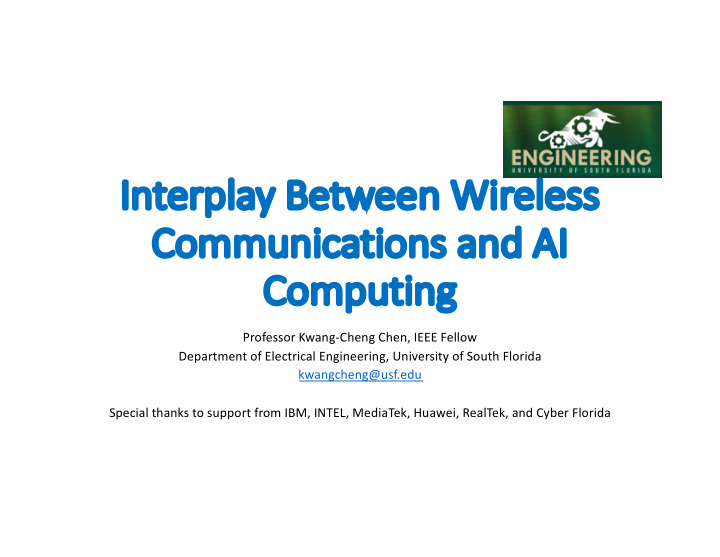



In Interpla lay Between Wir irele less Co Communi unications a ns and A nd AI Co Comput puting ng Professor Kwang-Cheng Chen, IEEE Fellow Department of Electrical Engineering, University of South Florida kwangcheng@usf.edu Special thanks to support from IBM, INTEL, MediaTek, Huawei, RealTek, and Cyber Florida
AI, AI, and AI ML, ML, and ML Yes! Are we going to talk AI/ML in communication systems and networks toward 6G? A sort of, but not exactly as you expect … 2019 VFCS Workshop KC Chen, USF EE 2
Slight Gossip § September 1989, precisely 30 years ago, a young person, after getting his PhD, was moving to New York to migrate his industrial and research career from satellite mobile communications (Communication Satellite Corp.) to wireless data networks (IBM T.J. Watson Research Center) § His PhD dissertation is about synchronization, a subject considered “very traditional research” in communication at that time § Yes, this young person is KC § What exactly happened in these 30 years? 2019 VFCS Workshop KC Chen, USF EE 3
1989-2019 2019 VFCS Workshop KC Chen, USF EE 4
1989-2019 2019 VFCS Workshop KC Chen, USF EE 5
1989-2019 2019 VFCS Workshop KC Chen, USF EE 6
1989-2019 2019 VFCS Workshop KC Chen, USF EE 7
1989-2019 GPU for Deep Learning 2019 VFCS Workshop KC Chen, USF EE 8
1989-2019 (Physics) 2019 VFCS Workshop KC Chen, USF EE 9
1989-2019 (Cancer Therapy) 1981 – American Dr. Bernard Fisher proves lumpectomy is as effective as mastectomy for breast cancer [4] 1989 – US FDA approves Carboplatin, a derivative of cisplatin, for chemotherapy [10] 1990 – US FDA approves tamoxifen for major additional use to help prevent the recurrence of cancer in "node- negative" patients [28] [29] From Wikipedia Precision Medicine 2019 VFCS Workshop KC Chen, USF EE 10
1989-2019 (2G – 5G) Title Development of CDMA for Cellular Communications, 1989 Citation On 7 November 1989, Qualcomm publicly demonstrated a digital cellular radio system based on Code Division Multiple Access (CDMA) spread spectrum technology, which increased capacity, improved service quality, and extended battery life. This formed the basis for IS-95 second-generation standards and third-generation broadband standards that were applied to cellular mobile devices worldwide. 2019 VFCS Workshop KC Chen, USF EE 11
1989-2019 Motorola DSP 56000 TI DSP 2019 VFCS Workshop KC Chen, USF EE 12
Semiconductor industry growing as Moore’s law drives advances in communications & networking The shown photo is Apply A12 Bionic Processor using TSMC 7nm IC fabrication (10B gates), while quantum limit for silicon IC fabrication is not far away. It is inappropriate to ignore computational complexity (i.e. energy) in ML/AI algorithms and systems. 2019 VFCS Workshop KC Chen, USF EE 13
Tiny Vision by Looking into History § What happened after WW II o Claud Shannon’s Information Theory o Von Neuman’s Game Theory and invention of Computer • The concept of utility and a priori probability in statistical decision theory • Yes, we are still using Von Neuman machine in modern computer architecture o A.N. Kolmogorov developed Probability Theory § Late 1960’s o Statistical Communication Theory was well established o Statistical Learning Theory was getting mature o Computers and Computer Networks going to be practical o Very soon, artificial intelligence would emerge beyond just concepts 2019 VFCS Workshop KC Chen, USF EE 14
Communication Technology Prior to 1980’s: Synchronization as Illustration 2019 VFCS Workshop KC Chen, USF EE 15
A Silent Communication Technology Advance in 1980’s Computing digitized samples, rather than analog processing, enables digital communication and networks and advances with computing and semiconductor technology. BTY, do not forget who made the critical contribution to the analysis of analog PLLs. 2019 VFCS Workshop KC Chen, USF EE 16
1989-2019 § The design of INMARSAT receiver in § State-of-the-art communication 1989 had inside a handset requires o One CPU handles multiple access o One DSP to handle physical layer communication o One co-processor for coding and o Two Digital Signal Processors to decoding calculate physical layer operations • 2000, KC’s undergraduate students developed a co-processor for TI-C6x o One co-processor dedicated to DSP to implement adaptive OFDM decoding FEC o One multi-core CPU to handle § Total four processors inside a protocol stack for layers 1-4 receiver, more complicated than o One multi-core Application Processor almost computers at that time with ANN § Surely, many processors and antennas for different purpose 2019 VFCS Workshop KC Chen, USF EE 17
Computer architecture is critically important in communications L.-F. Wei, the laureate of the Best Paper in 1989 IEEE Information Theory Society, in a private discussion 2019 VFCS Workshop KC Chen, USF EE 18
Recommend
More recommend